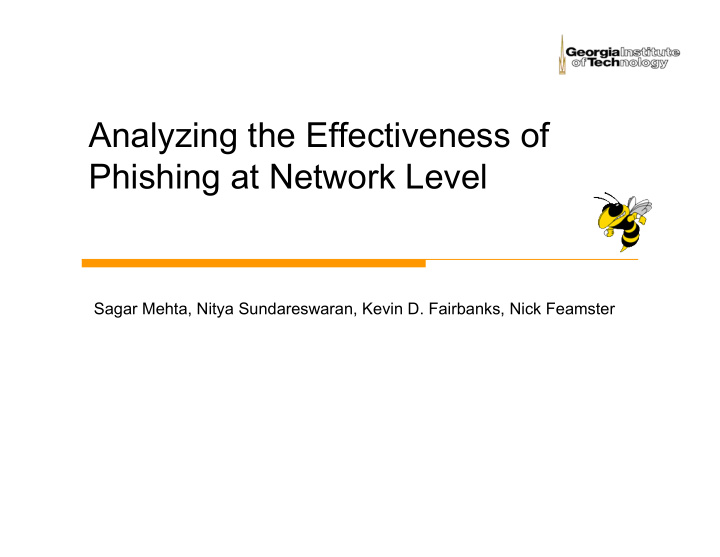



Analyzing the Effectiveness of Phishing at Network Level Sagar Mehta, Nitya Sundareswaran, Kevin D. Fairbanks, Nick Feamster
Motivation Source - Phishing Activity Trends Report July, 2006 , Anti-Phishing workgroup Our work done from Jan 07 – Apr 07
Related Work Mostly at application layer • Why phishing works ? – Dhamija et al • The Battle Against Phishing:Dynamic Security Skins - Dhamija et al • Detection of Phishing pages based on visual similarity - Liu et al • Phoney: Mimicking User Response to Detect Phishing Attacks -Chandrasekaran et al • A Framework for Detection and Measurement of Phishing Attacks - Doshi et al • Anti-Spam Techniques
Problem Statement • Looking at the effectiveness of Phishing from network level = Complementary approach to application layer analysis • Correlate Phishing mails to outgoing traffic • Analyze traffic destined to Phishing sites
System Architecture
Data sources • Spam Trap data • Netflow Records • DNS cache
Parsing script • Parsing script to obtain urls from spam • Filter using heuristics to obtain phishing urls • anchor text and actual link disagree • redirection – http 302, meta keyword • presence of certain keywords • presence of ip address in place of domain name • Caveats: • Human intervention for correct interpretation of URL • http://www.example-com, Replace “-”with “.” In the above link • http://www.example .com, Remove space in the above link • Attached .jpg images that provide the URL address – no OCR Deceptive user names e.g. ‘www.example1.com@example2.com’ •
Querying Script Querying script to map phishing domains to IP addresses Simulating HTTP client to follow redirects • Status code 300-307 in HTTP response • Meta redirects Caveat • Avoid corrupting the trace while mapping phishing domains to IP addresses by directing queries to a foreign name server Extracted ip addresses to further query netflow data from GTRNOC to get netflow tuples using src ip, src port , dest ip, dest port as ‘key’
Interaction with known phishing Sites from PhishTank – wide varation in byte distribution even when interacting with sites imitating the same website
Similar variation in connection time distribution even when interacting with sites imitating the same website
How many unique phishing sites did a source address visit ?
How many times a connection was made to a phishing site ?
96 hour window around the receipt of Bank of America phishing email in the spam trap
Connections made by diff src addresses to Bank of America phishing site – Observations in line with “persistent connection behavior of browsers” by wang et al
Percentage Bytes
Percentage Seconds
Challenges while analyzing phishing at network level • Lack of application layer context • Not everybody sees the same set of spam/phishing emails • Redirection Techniques • Avg lifetime of a phishing site typically very small • Timing differences • Multiple Domain Hosting • Other researchers on the same network
Recommendations and Future Work • Combined Data Sources • Application Level Sources • DNS Traces • Multiple Vantage Points - Different Universities with Spam Traps • Can help address questions about - • Targeted Phishing • Percentage Phishing Mails per Spam Trap
Acknowledgements • "The logs and netflow traces used in this work were made available by the Georgia Tech Research Network Operations Center (www.rnoc.gatech.edu)
96 hour window around the receipt of phishing email about site hosted on yahoo geocities in the spam trap
Percentage Bytes
Percentage Seconds
Recommend
More recommend